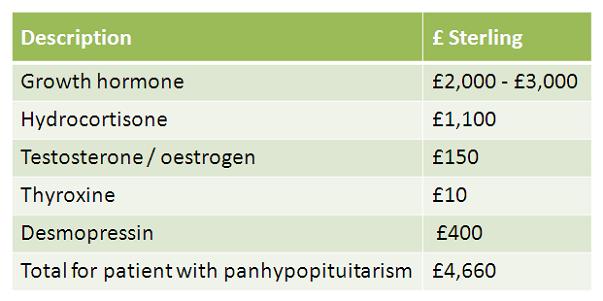Post-traumatic hypopituitarism: recognising the signs

Joanna Lane
Joanna Lane addresses the issue of post-traumatic hypopituitarism and how it is largely under-diagnosed and questions what we can do to change this.
In 2010, Alex Butler used social media to transform patient experience in his ground-breaking Psoriasis 360 campaign. In 2012, another neglected but serious condition is crying out for the same treatment – post-traumatic hypopituitarism, or PTHP.
Valerie Vaz MP outlined the situation in a recent Early Day Motion.
‘That this House notes that head injury patients are at risk of post-traumatic hypopituitarism (PTHP) which may appear immediately after head injury or up to decades later, further notes that the effects of pituitary damage can include infertility, failure to grow in children, muscle loss in adults, weight problems, fatigue, depression, loss of sex drive, erectile dysfunction in men and loss of periods in women, is concerned about the increased risk of suicide after head injury and the potential links to PTHP, is further concerned that patients may not be warned of or diagnosed with PTHP following a head injury as the current sample discharge letter in the National Institute for Health and Clinical Excellence (NICE) head injury guideline makes no reference to PTHP, acknowledges that PTHP can be effectively treated with hormone replacement therapy, acknowledges that athletes and football players may be at particular risk owing to exposure to repetitive mild head trauma, . . .’
 ,
"In 2012 another neglected but serious condition is crying out for the same treatment – post-traumatic hypopituitarism..."
 ,
Dry language masks the human anguish. James Smith, a PTHP sufferer, said on Radio Solent in March:
‘I'd been out with clients on a corporate entertainment evening and . . . some lads saw me and decided to rob me, I was hospitalized for nearly 3 weeks, broken ribs, nearly lost my eye, severe head trauma, . . . I healed reasonably quickly, but when I was discharged, that was it . . .no real after-care, and I guess that's when I started to fall way behind . . .- not being able to get up, not being able to go to sleep, not being able to talk properly, I totally went into my own shell, became fearful of pretty much everyone and everything, even the phone ringing was a nightmare for me, couldn't face a thing. I tried to take my life two or three times, and that was after weeks and weeks and weeks of just continuing negative thoughts. [Luckily] my endocrinologist . . . identified what one of the problems could be. During the attack I received head trauma which affected my pituitary gland. . . Now that gland produces major chemicals which basically enable a human to function so the treatment is to substitute some of those chemicals, hormones, and immediately after receiving those you start to feel better. If I hadn't received help I guess I'd be no further forward, and probably - I'd hate to say it - maybe even dead.’
To quote an email from another, recently diagnosed, patient:
‘Sometimes you feel that there is just no way out and taking your own life is the only option. I considered it many many times, thinking this would be the final outcome if I didn’t get fixed as I didn’t know how much more of it I could take.’
So how many are affected? According to large systematic reviews4,5 more than 25% of head injury survivors. That means more than 35,000 people every year are affected by PTHP. So why are less than 500 getting diagnosed?
Ms Vaz MP puts her finger on it. NICE is silent on PTHP in the head injury guideline, and the patient is not warned.
 ,
"That means more than 35,000 people every year are affected by PTHP. So why are less than 500 getting diagnosed?"
 ,
Even now, as they update the guideline, NICE have informed stakeholders that PTHP does not fall within the scope, claiming that it is a ‘late complication’ whereas the guideline is for acute care. Yet pituitary complications during the acute stage can be life-threatening (e.g. ACTH deficiency, diabetes insipidus), and their scope document talks of ‘persistent disability or even death’ which can result from complications which can be ‘minimised or avoided with early detection and appropriate treatment.’ It is not even clear yet whether NICE will warn the patient in the revised discharge advice.
Hypopituitarism can be very expensive to treat, and after decades of non-diagnosis there is undoubtedly a ‘backlog’ of hundreds of thousands of people.
What has pharma done so far? Some nibbling round the edges (Pfizer for example funded a PTHP study, and their KIMS database provides data for PTHP studies) but nothing to boost diagnosis above the 500 figure.
What can pharma do now? Alex Butler showed the way with his inventive exploitation of social media. It is crucial however to remember that PTHP sufferers are still in the dark. They may well have been told they have chronic fatigue syndrome and given CBT and exercise therapy, and will have no idea that a past head injury is to blame. It will not occur to them to google ‘head injury’ or ‘hypopituitarism’. So instead, an effective campaign must target patients searching under depression, erectile dysfunction, loss of libido, infertility, weight gain and chronic fatigue.
Other urgently needed steps are:
• To lobby NICE so that the head injury discharge note warns the patient and GP.
• To alert GPs (who are still largely unaware) through pharma reps and mobile apps.
• To alert clinics for depression, sexual dysfunction and fertility treatment .
• To approach personal injury lawyers. They are well placed to ensure good treatment for their head injury clients, regardless of cost.
If these actions are taken, pharma will fill the shocking vacuum left by the government and NHS, and step in to save this huge group of young men (head injuries mainly happen to young men) from relationship breakdown and suicide, and restore them to an active fulfilled life. What a triumph that would be.
 ,
"If these actions are taken, pharma will fill the shocking vacuum left by the government and NHS, and step in to save this huge group of young men..."
 ,
Facts and figures
• 135,000 people suffer traumatic brain injury each year.1
• Suicide risk is tripled / quadrupled after head injury.2
• In the first four years after head injury, the divorce rate is six times the national average.3
• The incidence of hypopituitarism is 20–30% after traumatic brain injury in most of the literature.4 One review even puts it at 30–80%.5
• Health Episode Statistics online gives no separate category for PTHP. There are only 500 cases of ‘other disorders of the pituitary gland’ and ‘disorder of the pituitary gland, unspecified’ which is where PTHP would fall. Only 1-2% of PTHP patients are being diagnosed.
• The army screens head-injured soldiers at Headley Court for this condition.6
• The drugs to treat a patient with panhypopituitarism (the worst case scenario) cost around £5,000 a year, see table below.
Figure 1: Drug costs for treating a patient with panhypopituitarism per year – drug costs kindly supplied by the Pituitary Foundation.
References
1. Headway website http://www.headway.org.uk/home.aspx
2. Teasdale T, Engberg A, Suicide after Traumatic Brain Injury, a population study, J Neurol Neurosurg Psychiatry 2001 October,71(4): 436-440 http://jnnp.bmj.com/content/71/4/436
3. ‘The Truth about Divorce after Brain Injury’ Kreutzer J et al, TBI Challenge Winter,3, 2010 finds 25% of relationships have broken down within 4.1 years of injury. This averages to 6.25% per year. This is nearly six times the ONS figure of 11.1 per 1,000 (i.e. 1.1%) in the general population. http://www.tbinrc.com/Websites/vcunrc/Images/TruthAboutDivorceWinter2010.pdf
4. Schneider H J et al, Hypothalamopituitary dysfunction following traumatic brain injury and aneurismal subarachnoid haemorrhage, JAMA Sept 26, 2007, Vol 298, No 12 2007 http://jama.jamanetwork.com/article.aspx?volume=298&,issue=12&,page=1429
5. Guerrero AF, Alfonso A, Traumatic brain injury-related hypopituitarism: a review and recommendations for screening combat veterans, Mil Med 2010 Aug:175(8):574-80 http://www.ncbi.nlm.nih.gov/pubmed/20731261
6. Freedom of Information request 20110620 FOI Lane-head injuries pituitary damage-reply
About the author:
Joanna Lane's son Chris committed suicide in 2008 aged 31. After his death it was found that he had always been impotent despite having a girlfriend for four years. It was this, coupled with the fact that at age 7 he had suffered a multiple skull fracture falling from a tree, that led his family to search for a link between erectile dysfunction and head injury, and to find the large body of research on PTHP. For the past four years Joanna has been doing all she can to make everyone aware of this serious complication of head injury.
Chris kept his depression and sexual problems hidden and lived his life stoically, always working hard and being a kind and loving son and brother. He studied engineering at Birmingham University but his subsequent career was in writing software. He worked first for Rover, then BMW and finally Skipton Building Society where he was much valued.
It is bitter to think that if only PTHP had been more widely known about, the GPs, counsellors and psychiatrist whom he consulted might have ensured he had hormone treatment, and he could perhaps have been alive today, happy with a wife and children.
You can visit Joanna’s blog here.
How can we increase awareness of PTHP?













